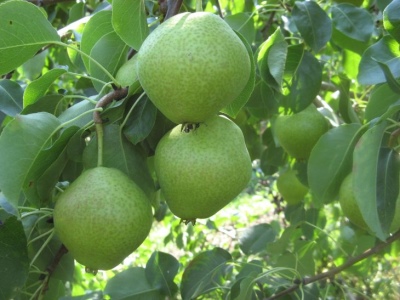
- Authors: Sverdlovsk Horticultural Selection Station
- Appeared when crossing: Beta x Victoria x Williams Rouge
- Fruit weight, g: 70-80
- Ripening terms: early autumn
- Fruit picking time: mid-September
- Appointment: fresh
- Growth type: medium or tall
- Yield: above average
- Crown: pyramidal
- Fruit shape: diamond-shaped
Chusovaya is a pear variety bred by Russian breeders. The cultivar is the result of crossing Beta, Victoria and Williams rouge pears. Let's take a closer look at this unique variety.
Description of the variety
The tree is medium or tall, grows up to 3.5-4 m. The crown is spreading, pyramidal. Leaves are green, have a pointed shape, their surface is smooth.
Fruit characteristics
The weight of pears of this variety is limited to 80 g, they develop in the shape of a diamond, are medium in size, have a green skin. The fruit retains its presentation for a month after harvesting, while the taste is not lost.
Taste qualities
The flesh of Chusovoy is creamy, tender, crunchy, contains a lot of moisture. Judging by the gardeners' reviews, the taste is very sweet, without acid, there is no astringency even in unripe fruits. Usually they are eaten fresh, but these pears are also suitable for making juices or compotes.
Ripening and fruiting
Chusovaya belongs to varieties with early autumn ripening, harvesting usually falls in mid-September.

Yield
The productivity of the variety is estimated very high, from 1 tree it is possible to get 50-60 kg of fruits.
Self-fertility and the need for pollinators
It is a self-fertile variety that does not require proximity to other varieties. But Chusovaya itself can be an effective pollinator for other trees. This species can be propagated by vegetative parts, sowing or grafting.
Landing
To make the plant of the presented variety feel comfortable, it is recommended to grow it on chernozem, loamy or sod-podzolic soils. If groundwater is close to the site, then the tree should be planted on a small mound. It is better to prepare the site for planting in advance, six months in advance. It should be leveled, removed weeds and dug up with humus, peat and wood ash.
Prepare the planting hole. Its walls should be steep, diameter - 80 cm, depth - 70 cm. The first layer should be drainage, then fertile soil mixed with peat, humus and river sand. The planting process is as follows.
Place a seedling in the middle of the finished hole.
Spread the root system to the sides so that the branches are evenly spaced.
Sprinkle with soil, tamp lightly, and water the planting site.
Make sure that the root collar is at ground level.
Add mulch to the tree trunk circle.


Growing and care
This variety is distinguished by its high winter hardiness, but in regions with harsh winters, it is still recommended not to neglect the shelter. It is allowed to grow Chusovaya in the Urals, in the Volga region, in central Russia. After planting, the tree does not need fertilizers - it has enough nutrients that were introduced at the planting stage. But you need to water a young seedling more often - up to several times a month. It is also important to protect the plant from rodents.



Disease and pest resistance
The presented variety can be affected by scab. Bordeaux liquid or fungicides help with this ailment. If the plant is damaged by moniliosis, then use the same remedies; liming will also protect against this disease.
If aphids are found on the leaves, then use ash and soapy water to fight insects. If you find a pear moth, use chemistry, and as a preventive measure, remove the carrion in a timely manner. Such a common "pear" enemy as the gall mite, the Chusovaya variety does not strike.

Like any other fruit trees, the pear needs protection from various diseases and pests. When planting a pear on your site, you need to know in advance what diseases you should beware of. To successfully carry out the struggle, it is necessary first to correctly identify the cause of the problem. It is important to distinguish signs of disease from manifestations of the presence of insects, mites, caterpillars and other types of pests.
Review overview
Judging by the reviews of summer residents, this pear is distinguished by its unpretentiousness, ease of care, and also excellent taste, despite the small size of the fruit. However, not every farmer can boast of the declared yield. So, in some regions, the variety begins to bear fruit only for 6-7 years.





































































